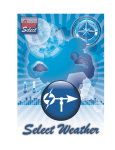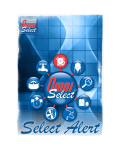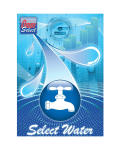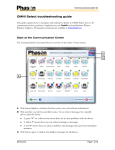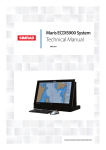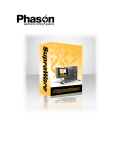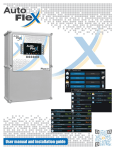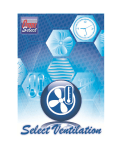Download Select Environments user manual
Transcript
©Phason Inc. All rights reserved. Printed in Canada 25042701 Limited warranty Software Phason Inc. (Phason) warrants for a period of 90 days from the date of purchase that the software product will execute its programming instructions when properly installed on the personal computer or workstation indicated on this package. Phason does not warrant that the operation of the software will be uninterrupted or error free. Should this software product fail to execute its programming instructions during the warranty period, the purchaser’s remedy shall be to return the software CD (media) to Phason for replacement. Should Phason be unable to replace the media within a reasonable amount of time, the purchaser’s alternate remedy shall be a refund of the purchase price upon return of the product and all copies. Media Phason warrants the media upon which this product is recorded to be free from defects in materials and workmanship under normal use for a period of 90 days from the date of purchase. Should the media prove to be defective during the warranty period, the purchaser’s remedy shall be to return the media to Phason for replacement. Should Phason be unable to replace the media within a reasonable amount of time, the purchaser’s alternate remedy shall be a refund of the purchase price upon return of the product and all copies. Notice of warranty claims The purchaser must notify Phason in writing of any warranty claim no later than 30 days after the warranty period expires. Limitation of warranty Phason makes no other express warranty, whether written or oral, with respect to this product. Any implied warranty of merchantability or fitness is limited to the 90 days of this written warranty. Some states or provinces do not allow limitations on how long an implied warranty lasts, so the above limitation or exclusion may not apply to you. This warranty gives specific legal rights and you may have other rights, which vary from state to state, or province to province. Exclusive remedies The remedies provided above are the purchaser’s sole and exclusive remedies. Phason shall not be liable for any direct, indirect, special, incidental, or consequential damages (including lost profit) whether based on warranty, contract, tort, or any other legal theory. Some states or provinces do not allow the exclusion or limitation of incidental or consequential damages, so the above limitation or exclusion may not apply to you. Warranty service Warranty service may be obtained from the Phason office location indicated in the user manual or service booklet. i Service and technical support Phason will be happy to answer all technical questions that will help you use your OMNI-Select system. Before contacting Phason, collect the following information: A description of the problem A description of what you were doing before the problem occurred The model(s) and serial number(s) of the devices Any messages displayed by the software My dealer’s name: How to contact my dealer: Street/PO Box City State/Province Zip/Postal Phone Fax E-mail Web site 2 Terracon Place Winnipeg, Manitoba Canada R2J 4G7 ii Phone Fax E-mail Web site 204-233-1400 204-233-3252 [email protected] www.phason.ca About the manual This manual describes the features of the Select™ Environments module for OMNI-Select and how to use them. In addition to reading this manual, you should be familiar with the following. Microsoft Windows™ – how to perform basic Windows functions such as opening and closing windows, finding and opening files, saving and closing files, as well as using a mouse and keyboard. OMNI hardware and equipment – devices such as Local Environment Monitors. You should also be familiar with the equipment connected to them, such as temperature probes, sensors, and so on. Styles The following styles are used in the manual. All buttons and tabs are bolded. For example, click OK to save the changes. All filenames and directories are in a monospace font. For example, the reports directory in Windows is C:\Users\<username>\Documents \phason\OmniSelect\Reports\. Hint/tip This is a hint or tip. It contains helpful information that may make it easier for you to set up or use Select Environments. Note This is a note. It contains important information that may help you better understand Select Environments. iii Table of contents Chapter 1: Introducing Select Environments .................................................................... 5 Introducing Select Environments .............................................................................................................. 5 Select Environments features ................................................................................................................ 5 OMNI-Select requirements .................................................................................................................... 6 Installing and logging in to OMNI-Select ................................................................................................... 6 Installing OMNI-Select ........................................................................................................................... 6 Logging in to OMNI-Select .................................................................................................................... 6 Shutting down OMNI-Select .................................................................................................................. 7 Select Environments windows................................................................................................................... 8 Communication Center.......................................................................................................................... 8 Configuration window ............................................................................................................................ 9 Settings window................................................................................................................................... 10 Reports window ................................................................................................................................... 11 Chapter 2: Configuring Select Environments .................................................................. 12 Configuring Select Environments ............................................................................................................ 12 Adding, editing, and removing Environment Monitors ........................................................................ 13 Activating and deactivating Environment Monitors ............................................................................. 14 Configuring Environment Monitors...................................................................................................... 15 Setting alarms .......................................................................................................................................... 18 Programmable alarms ......................................................................................................................... 19 Setting temperature or auxiliary alarms ............................................................................................... 20 Setting pulse counter alarms ............................................................................................................... 21 Setting digital input alarms .................................................................................................................. 23 Chapter 3: Analyzing data ............................................................................................... 24 Select Environments reports ................................................................................................................... 24 Report descriptions ............................................................................................................................. 25 Creating reports ................................................................................................................................... 28 Selecting dates .................................................................................................................................... 30 Select Environments charts ..................................................................................................................... 30 Viewing charts...................................................................................................................................... 31 Status viewer ........................................................................................................................................... 33 Appendices ...................................................................................................................... 34 Appendix A: Environment Monitor worksheet ......................................................................................... 34 Appendix B: Troubleshooting .................................................................................................................. 39 Appendix C: Automatically start OMNI Select after a power outage ...................................................... 39 Appendix D: Glossary .............................................................................................................................. 40 Index ........................................................................................................................................................ 42 iv Chapter 1: Introducing Select Environments Introducing Select Environments Select Environments allows you to monitor critical conditions anywhere at your site. Select Environments works with the Local Environment Monitors (LEMs) and continuously monitors critical conditions such as power failure, humidity, temperature, pH, pressure, door contacts, and much, much more. Select Environments allows you to monitor and report on conditions that are important to your facility. Using multiple Local Environment Monitors, you can monitor conditions in every area of your site. Select Environments includes a status viewer, a chart, and three reports. These tools are useful for tracking down problems that have occurred in a zone, analyzing the effects of different ventilation strategies, monitoring environmental conditions, and more. Select Environments features “Near real-time” information collection and display Information at a glance Easy-to-read status displays Easy-to-use charting and reporting tools Programmable alarms with notification and logging Information display Status Viewer displays the current conditions for each input on an Environment Monitor. With the Status viewer, you can quickly determine if there are any problems in a zone. Charts display historical information for your various sensors and show up to two different types of analog data on a single chart. One of the most important features is the ability to view the cause and effect of different inputs. For example, you can see how opening a door affects other conditions such as temperature or humidity. History reports give you exact data for the selected date range. History reports are an excellent way to keep historical records of conditions so you can compare them over time. 5 Configuration and settings reports list configuration and settings for an Environment Monitor. Configuration reports provide easy reference and a backup in case of data loss. For more information about Select Environments viewers, charts, and reports, read Chapter 3: Analyzing data on page 24. OMNI-Select requirements For Select Environments to work properly, your system must meet specific computer requirements. For the latest computer and system requirements, visit www.phason.ca or contact Phason Customer Support at 204-233-1400 or [email protected]. Installing and logging in to OMNI-Select Installing OMNI-Select OMNI-Select has an installation wizard that guides you through the installation. To install Select Environments 1. Insert the installation CD or USB into your computer. The Installation Wizard should start automatically. If it does not start automatically, find and start the file Install_OmniSelect.exe on the CD or USB drive. 2. Follow the instructions on the screen. Logging in to OMNI-Select All OMNI-Select users must have a user name and password to access settings, configuration, viewers, and reports. Security helps prevent unauthorized access and allows OMNI-Select to track which users have performed certain tasks within the program. Each time you open the Main window—the one with the Settings/Configuration/Reports buttons at the top—the OMNI-Select login window displays. 6 Installing and logging in to OMNI-Select The default username is sysadmin and the password is omniadmin. For more information about user names and passwords, see the OMNI-Select user manual. Set your computer to restart and log in after a power failure. For more information, read Appendix C: Automatically start OMNI Select after a power outage on page 39. To access settings, configuration, viewers, and reports, you need to log in to OMNI-Select. To log in to OMNI-Select, you must have a username and password. To log in to OMNI-Select 1. On the Communication Center, click Login. The OMNI-Select login window displays. 2. Beside User name, type your user name. 3. Beside Password, type your password. 4. Click OK. Shutting down OMNI-Select Your computer should be running at all times. When your computer is not running, the OMNI- Select services are not running. When the OMNI-Select services are not running, equipment operates at its last settings, but OMNI-Select cannot collect information or update settings. If you have to shut down your computer, start it again as soon as possible. Do not use power management settings such as "sleep" or "hibernate" mode. When your computer is in these modes, OMNI-Select does not function properly. Set your computer to restart and log in after a power failure. For more information, read Appendix C: Automatically start OMNI Select after a power outage on page 39. Protect yourself from short power interruptions and surges by installing a UPS (uninterruptible power supply). You can get a UPS at your local electronics store. 7 Select Environments windows The following section is an overview of the main Select Environments windows. Communication Center The Communication Center is the only area of OMNI-Select that is available to all users, regardless of their access. The Communication Center is also the gateway to the Main window, where you can access settings, configuration, and reports. The Communication Center displays all communication, status, and alarm messages from OMNISelect modules and devices. Check the Communication Center regularly to ensure systems functioning normally and to see if there are problems or potential problems. The Communication Center uses a message system to notify you of all new alarm problems and events that have occurred for each OMNI device. Acknowledge the messages each time you visit the display, as they are dealt with. Any new alarm problems will display on the device’s icon, indicating that something needs your attention. A C B D This button opens a window that displays version information. A B This area lists your devices and their status. To see a list of communication and system messages for a specific device, click on that device. C This button opens a window that displays all messages for all devices. D This button opens the OMNI-Select login window, which is where you enter your username and password to access other areas of the system. An alarm needs to be acknowledged and the condition must return to normal before it will trigger again. 8 Select Environments windows For more information about logging in to OMNI-Select, read Installing and logging in to OMNISelect on page 6. For more information about the Communication Center, see Monitoring the Communication Center in the OMNI-Select user manual. Configuration window The Configuration window is where you configure the structure of your site, as well as Select Environments options you configure seldom or only once at the beginning. A B C A This button displays the configuration window. B This button displays the configuration for Select Environments. C This is a list of Environment Monitors in each building at your site and where you select the device you want to configure. For more information about the Configuration window and configuring Environment Monitors, Read Chapter 2: Configuring Select Environments on page 12. 9 Settings window The Settings window is where you setup alarm conditions for each input. A B C A This button displays the Settings window. B This button displays the settings for Select Environments. C This is a list of Environment Monitors in each building at your site and where you select the device you want to set up. For more information about the Settings window and setting up Environment Monitors, read Setting alarms on page 18. 10 Select Environments windows Reports window A C B A This button displays the reports window. B This button displays the available Select Environments reports. C This is where you select the report and details. For more information about the Reports window, read Creating reports on page 28. 11 Chapter 2: Configuring Select Environments Configuring Select Environments The Configuration window is where you configure the structure of your site, as well as Environment Monitor options you configure seldom or only once at the beginning. A D B F C E G A This button displays the configuration window. B This button displays the configuration for Select Environments. C This is a list of Environment Monitors in each building at your site and where you select the device you want to configure. D This is the name and address of the selected Environment Monitor. 12 Configuring Select Environments E The top two buttons open the Environment Monitor description window, which is where you add a new Environment Monitor or edit the selected Environment Monitor. The bottom button removes the selected Environment Monitor from your system. F This button opens the Environment Monitor configuration window, which is where you configure the selected Environment Monitor. G This is where you activate or deactivate the selected Environment Monitor. Adding, editing, and removing Environment Monitors Select Environments uses an address, a unique eight-digit code, to locate and identify each Environment Monitor. Each Environment Monitor is programmed with an address before it leaves the factory. To locate the address for a specific Environment Monitor, check inside the cover. For more information, read the LEM installation guide. Because remembering eight-digit codes to identify Environment Monitors is all but impossible for us humans, Select Environments makes it easier by allowing you to give each device a name. When giving a device a name, try to make the name as descriptive and useful as possible. For example, North-Room 1, North-Room 2, South-Room 1, and South-Room 2 are more descriptive and useful than LEM 1, LEM 2, and so on. When you add a new Environment Monitor, none of the inputs are enabled. To enable inputs, you must configure the Environment Monitor. For more information, read Configuring Environment Monitors on page 15. Before you can add Environment Monitors, you must have at least one building. For information about adding buildings, see the OMNI-Select user manual. If you are using a Phason Wireless Adapter (PWA) for communication, see the PWA installation guide. To add an Environment Monitor 1. In the main window, click Configuration, and then Environments. 2. Click Add Environment Monitor. The Environment Monitor description window displays. 3. Beside Name, type a descriptive name (maximum 28 characters) for the Environment Monitor. 4. Beside Address, type the address of the new Environment Monitor, exactly as it appears on the product. For information about where to find the address, see the LEM installation guide. 5. Beside Building, select the building in which the Environment Monitor is located. 6. If you are using wireless communication, beside Wireless adapter, select the address of the adapter (PWA or iWire) connected to the Environment Monitor. 7. Click OK to save the information and return to the Configuration window. 13 When you add an Environment Monitor, its status is automatically set to active. If you want the Environment Monitor to be inactive, follow the Activating and deactivating Environment Monitors instructions below. To edit an Environment Monitor 1. In the main window, click Configuration, and then Environments. 2. Below Your Environment Monitors, select the Environment Monitor you want to edit and then click Edit Environment Monitor. The Environment Monitor description window displays. 3. Make the changes. Beside Name, type a descriptive name (maximum 15 characters) for the device. Beside Address, type the address of the device, exactly as it appears on the product. For information about where to find the address, see the LEM installation guide. Beside Building, select the building in which the device is located. If you are using wireless communication, beside Wireless adapter, select the address of the adapter (PWA or iWire) connected to the Environment Monitor. 4. Click OK to save the device information and return to the Configuration window. To remove an Environment Monitor When you remove an Environment Monitor, you permanently remove all its data. 1. In the main window, click Configuration, and then Environments. 2. Below Your Environment Monitors, select the Environment Monitor you want to remove and then click Remove Environment Monitor. A warning message displays. 3. To remove the Environment Monitor, click Yes. To cancel and return to the previous window, click No. Activating and deactivating Environment Monitors When you add an Environment Monitor, its status is automatically set to active. When an Environment Monitor is active, you can configure and set up the Environment Monitor, as well as view and print charts and reports for it. 14 Configuring Select Environments When an Environment Monitor is inactive, there is no communication with the device. You cannot send setting changes or collect and receive data from it. You can view and print charts and reports for it using existing data. Deactivating devices that are not in use can help improve system performance. To activate or deactivate a Environment Monitor 1. In the main window, click Configuration, and then Environments. 2. Below Your Environment Monitors, select the Environment Monitor you want to activate or deactivate. 3. Below Active, click and drag the slider to the status you want. Configuring Environment Monitors Environment Monitors have 11 inputs. When you add a new Environment Monitor, none of the inputs are enabled. You need to configure the Environment Monitor and enable the inputs. About the data logging interval The logging interval is how often the Environment Monitor takes a reading from the sensors. If you set the logging interval for 10 minutes, you will get a reading for each sensor every 10 minutes. The logging interval is also the sample interval for the pulse counter. The logging interval is the same for all sensors connected to the Environment Monitor. About the temperature input Each Environment Monitor comes with a standard 30-foot temperature probe you can connect to the temperature (TEMP) input on the circuit board. Phason’s standard 3K temperature probe monitors temperatures ranging from -49 to 122°F (-45 to 50°C). A High Temperature Probe (HTP) is available for monitoring temperatures ranging from 86 to 302°F (30 to 150°C). Phason's standard probes are available in 1, 6, 30, 75, or 150-foot cable lengths. You can extend the cable up to 500 feet using extension cable. 15 About auxiliary inputs Each Environment Monitor has three auxiliary inputs (AUX1, 2, and 3) you can use to monitor additional analog sensors. 3K temperature probe: a standard Phason temperature probe, same as the TEMP input. High Temperature Probe: a High Temperature Probe (model HTP) monitors temperatures ranging from 86 to 302°F (30 to 150°C). HTPs come with a 6-foot cable. You can extend the cable up to 500 feet using extension cable. Humidity sensor: a Phason Relative Humidity Sensor (model RHS or RHS-P). Static pressure sensor: a Phason Static Pressure Sensor (model SPS-1 or SPS-2). 1K temperature probe, pH probe, and Raw voltage: for more information, contact Phason customer support. About the counter input Each Environment Monitor has a pulse counter input (COUNT) you can use to monitor devices such as a water meter with pulse output. About digital inputs Each Environment Monitor has six digital inputs (IN1 to IN6) you can use for monitoring dry (unpowered) contacts from relays or switches, such as door contacts. For digital inputs, you must select a normal condition. The normal condition is the position (open/low or closed/high) the switch or monitoring device will be in while the condition it monitors is normal. For example, if you connect a magnetic door contact switch to a door and the door is normally closed, then the switch would normally be closed. In this case, you would set the normal condition to “closed”. To configure Environment Monitors 1. In the main window, click Configuration, and then Environments. 2. Below Your Environment Monitors, select the Environment Monitor you want to configure. 3. Click Configure Environment Monitor. The Environment Monitor configuration window displays. 16 Configuring Select Environments 4. Beside Data logging interval, select the existing value and then enter a new one, or click Up or Down to increase or decrease the interval. 5. Below Environment Monitor inputs, select the input you want to configure. The window displays the configuration items for the selected input. 6. Configure or make the changes to the input. To enable or disable the input, select or deselect Enable input. There is a checkmark in the box when enabled. To enter or change the name, beside Name, type a description for the input. The name is how you will identify the input in charts and reports. Temperature only: below Function, select the type of probe connected to the input. Auxiliary 1 to 3 only: below Function, select the type of sensor or equipment connected to the input. Pulse counter only: below Function, select the type of counter. Digital inputs 1 to 6 only: below Function, select the normal condition of the switch/dry contact. 7. Repeat steps 5 and 6 for each input you want to configure. 8. Click OK to save the changes and return to the Configuration window. 17 Setting alarms The Settings window is where you set alarms. A D E F B C G A This button displays the Settings window. B This button displays the settings for Select Environments. C This is a list of Environment Monitors in each building at your site and where you select the Environment Monitor you want to set up. D This is the name and address of the selected Environment Monitor. E This button opens the Status window, where you can view the status of the selected Environment Monitor. F This button opens the Environment Monitor settings window, which is where you edit the alarm settings. G This button opens the Select Alert window. Select Alert is an automatic alarm condition notification system. For more information about Select Alert, visit www.phason.ca. 18 Setting alarms Programmable alarms Select Environments has the following programmable alarms. High/low temperature, pulse counter, and auxiliary input alarms Digital input alarms Communication errors Select Environments displays alarm messages in the Communication Center and the Status Viewer window. Before you set alarms, you need to be familiar with the following terms. An alarm needs to be acknowledged and the condition must return to normal before it will trigger again. Fault condition A fault condition is a condition outside of the normal range of operation. For temperature, pulse count, and auxiliary inputs, the normal range is any value between the low and high alarm settings. For digital inputs, the normal condition is either open/low or closed/high, whichever you selected in the Environment Monitor configuration window. A fault condition is anything that is not normal. Fault duration Fault duration is the amount of time a fault condition must be present before it becomes an alarm condition. The minimum fault duration is 1 second; the maximum is 30 minutes. Fault durations help prevent unnecessary alarms. For example, on a digital input that is monitoring a door contact on a walk-in cooler, you would not want an alarm each time someone opened the door. However, you might want an alarm if the door was left open for more than a few minutes. In this case, you could set the fault duration for three minutes. Alarm condition An alarm condition is a fault condition that has been constantly present for at least the specified fault duration. Pulse counter alarms have different settings. For more information, see Setting pulse counter alarms on page 21. 19 Communication errors For each Environment Monitor, you have the option to enable communication alarms or warnings. Communication errors occur if an active device, such as an Environment Monitor, becomes unresponsive. When you enable communication alarms and there is a communication error, OMNI Select displays a red X in the Communication Center. If you have Select Alert, the program dials out. When you enable communication warnings and there is a communication error, OMNI Select displays a yellow ! In the Communication Center. If you have Select Alert, the program does not dial out. Setting temperature or auxiliary alarms Separate high and low alarms are available for each of the temperature and auxiliary inputs. Any changes you make to the alarm settings do not take effect until you close the Environment Monitor settings window. To set temperature or auxiliary alarms 1. In the main window, click Settings, and then Environments. 2. Below Your Environment Monitors, select the Environment Monitor you want to set up. 3. Click Edit settings. The Environment Monitor settings window displays. By default, the TEMP input is selected. 20 Setting alarms 4. Below Input, select the input you want to set up. The window displays the settings for the selected input. 5. Make the changes to the alarm settings. To enable or disable an alarm, select or deselect Enable... beside the alarm you want to change. There is a checkmark in the box when enabled. To change a set point, select the existing value and then enter a new one, or click Up or Down beside the set point you want to change. To change a fault duration, select the existing value and then enter a new one, or click Up or Down beside the duration you want to change. 6. Click Apply to save the settings for the input. 7. Repeat steps 4 to 6 for each input you want to set up. For information about setting pulse counter alarms, read Setting pulse counter alarms below. For information about setting digital input alarms, read Setting digital input alarms on page 23. 8. Click Close to save the changes and return to the main window. Setting pulse counter alarms You can set high and low alarms for the pulse counter input. Pulse counter alarms have different settings than the other alarms. Consecutive fault samples The consecutive fault samples setting is the number of consecutive fault durations (samples) that must have a fault condition before an alarm condition occurs. For example, you set the logging interval to 15 minutes, the high pulse count set point to 500 pulses, and the consecutive fault samples to 3. If there are 3 consecutive samples with more than 500 pulses, there will be an alarm condition. 15 minutes= one sample Three consecutive fault samples = alarm condition 600 Pulses 500 400 300 200 600 pulses = fault 550 pulses = fault 495 pulses = normal 550 pulses = fault 600 pulses = fault 650 pulses = fault 100 0 0 15 High pulse count set point 30 45 Time (minutes) 60 75 90 21 To set the logging interval, go to the Environment Monitor configuration. For more information, read Configuring Environment Monitors on page 15. To set pulse counter alarms 1. In the main window, click Settings, and then Environments. 2. Below Your Environment Monitors, select the Environment Monitor you want to set up. 3. Click Edit settings. The Environment Monitor settings window displays. 4. Below Input, select COUNT. The window displays the settings for the pulse counter input. 5. Make the changes to the alarm settings. To enable or disable an alarm, select or deselect Enable... beside the alarm you want to change. There is a checkmark in the box when enabled. To change a set point, select the existing value and then enter a new one, or click Up or Down beside the set point you want to change. To change a consecutive fault samples, select the existing value and then enter a new one, or click Up or Down beside the setting you want to change. 6. Click Apply to save the settings for the input. 7. Repeat steps 4 to 6 for each input you want to set up. For information about setting digital input alarms, read Setting digital input alarms on page 23. For information about setting analog alarms, read Setting temperature or auxiliary alarms on page 20. 8. Click Close to save the changes and return to the main window. 22 Setting alarms Setting digital input alarms Because digital inputs read only one state or the other, for example opened or closed, they have only one alarm instead of high or low. To set digital input alarms 1. In the main window, click Settings, and then Environments. 2. Below Your Environment Monitors, select the Environment Monitor you want to set up. 3. Click Edit settings. The Environment Monitor settings window displays. 4. Below Input, select the input you want to set up. The window displays the settings for the selected input. 5. Make the changes to the alarm settings. To enable or disable an alarm, select or deselect Enable alarm. There is a checkmark in the box when enabled. To change the fault duration, beside Fault duration, select the existing value and then enter a new one, or click Up or Down. 6. Click Apply to save the settings for the input. 7. Repeat steps 4 to 6 for each input you want to set up. For information about setting pulse counter alarms, read Setting pulse counter alarms on page 21. For information about setting analog alarms, read Setting temperature or auxiliary alarms on page 20. 8. Click Close to save the changes and return to the main window. 23 Chapter 3: Analyzing data Select Environments reports One of the great advantages of Select Environments is the detailed reports that are available. OMNI-Select reports are available in preview/PDF or CSV format. Preview/PDF These reports display using OMNI-Select's built-in Report Preview window. From there, you can print or save reports as a PDF (portable document format). CSV You can import CSV reports into a third-party reporting, database, or spreadsheet program, or email them off-site for evaluation. CSV reports are not suitable for normal viewing. 24 Select Environments reports Report descriptions Configuration and Settings Report (below) Environment History Report (on page 26) Pulse Counter History Report (on page 27) Configuration and Settings Report Configuration and Settings Reports provide an easy reference for configuration and settings and can be a backup in case of data loss. The report lists the current configuration and settings for the selected Environment Monitor. Configuration and Settings Reports are available only in preview/PDF format. Information about the report The configuration and settings for the Environment Monitor, sorted by input 25 Environment History Report Environment History Reports give you exact data for the period of time you choose. They are an excellent way to keep historical records of environmental conditions and compare them over time. You select an Environment Monitor, a date range, and up to five inputs. There will be an entry in the report for each time the Environment Monitor recorded data. Alarms are shown in red. Environment History Reports are available in preview/PDF and CSV formats. Information about the report The data for the time period, sorted by date and time. Alarm conditions are in red. 26 Select Environments reports Pulse Counter History Report The Pulse Counter History Report displays all pulse count data for the date range you choose. There will be an entry in the report for each time the Environment Monitor recorded data. Alarms are shown in red. Pulse Counter History Reports are available only in preview/PDF format. Information about the report The data for the time period, sorted by date and time. Alarm conditions are in red. 27 Creating reports A D E B F C G H A This button displays the Reports window. B This button displays the available Select Environments chart, viewer, and reports. C This is where you select what you want to view or create. D This is where you to select the Environment Monitor. E This is where you to select the inputs for the Environment History Report. F If required, this is where you select the date range. G This is where you to select the format for the Environment History Report. H This button creates and/or displays the chart, viewer, or report. 28 Select Environments reports Formats, dates, and other information The following table shows the formats available, date type, and other information required for the chart, viewer, and reports. Name Format Date type Other information required Configuration and Settings Report Environment History Report Pulse Counter History Report Status viewer Environment chart Preview/PDF Preview/PDF/CSV Preview/PDF Viewer Chart Current Date range Date range Current Date range Environment Monitor Environment Monitor, inputs Environment Monitor Environment Monitor Environment Monitor To create reports 1. In the main window, click Reports, and then Environments. 2. Below Reports, select the type of report you want to create. The window updates and adds any additional information required to create the report. 3. Below Your Environment Monitors, select the Environment Monitor you want in the report. 4. Select the remaining details. If you are creating a report that requires a date range, below Dates, select the start and end dates. For more information, read Selecting dates on page 30. If you are creating an Environment History Report, below Inputs, deselect any inputs you do not want in the report and then select the ones you want. You can select up to five inputs. If you are creating an Environment History Report and want to export the data to thirdparty software, below Report format, select CSV. 5. Click Create. If you created a printable report, OMNI-Select displays your report in the Report Preview window. From here you can print or save your report by clicking the appropriate button. If you created a CSV report, the Save As window displays so that you can select a location and save your report. After saving your report, it displays in your default editor. In Windows 7, the default reports directory is C:\Users\<username>\Documents\Phason\OmniSelect\Reports. <username> is the name you use to log on to your computer. Reports print to the default printer using the default settings. 6. Click Close to return to the Reports window. 29 Selecting dates Select Environments history reports and charts require a date range. To select date ranges 1. Beside Start date, click . The date selector displays. 2. Select a start date: To move backward or forward through the months, click or . To select a specific month, click the month on the calendar and then select the month you want. To move forward and backward through the years, double-click the year on the calendar and then select the year you want. 3. Repeat steps 1 and 2 for the end date. Select Environments charts Environment charts are useful for tracking problems that have occurred, analyzing the effects of different ventilation strategies, and monitoring environmental conditions. For example, you can compare temperatures from probes located in different areas of a room to see how the temperature compares at different times of the year. Using this information, you can make any necessary adjustments to your ventilation strategy to help offset any time-of-year effects. Environment charts are very versatile. You can compare inputs (sensors), including up to 2 different types of analog data on a single chart. For example, you can compare temperature and humidity values at the same location in a room. The ability to compare the humidity and temperature information can help you develop and maintain an effective ventilation strategy. One of the most important features of Environment charts is the ability to view the cause and effect of different inputs. For example, with digital inputs you can see when a door has been opened. Using the Environment chart, you can see how opening the door affects other conditions such as temperature, humidity, and static pressure. Another example is connecting a digital input to a heater or single-stage fan. You can determine the run time and compare it to temperature in the room. 30 Select Environments charts Viewing charts C A B D G E H F A I This is a list of Environment Monitors in each building at your site and where you select the Environment Monitor you want to view. B This is the chart for the selected group and date range. You can zoom in and scroll along the chart. C This is the legend for the chart. It shows which color represents which input. D This is where you select the date range. E This button refreshes the chart and leaves the zoom level the same. Refresh the chart if you change the date range. F This allows you to change the width of the lines in the chart. G This is where you select the inputs. You can display up to two different types of analog inputs and up to six digital inputs on the same chart. H This button prints the chart. I This button resets the zoom/magnification. Environment charts display all state changes for digital inputs. You cannot save Environment charts, but you can view them again as long as the information remains in the database. 31 To view charts 1. In the main window, click Reports, and then Environments. 2. Below Chart, select Environment chart. The window updates. 3. Below Dates, select the start and end date for the chart. For more information, read Selecting dates on page 30. 4. Below Your Environment Monitors, select the Environment Monitor you want in the chart. 5. Click Show chart. The Environment chart displays using the inputs that were selected the previous time. 6. Make any changes to the chart. To change the inputs, below Inputs, deselect any inputs you do not want to view and then select the ones you want to view. As you select or deselect inputs, the chart updates. To change the Environment Monitor, below Your Environment Monitors, select the one you want to view. As you select different Environment Monitors, the chart updates. To change the date range, below Dates, select a new start and/or and date and then click Refresh chart. The chart updates but if you zoomed in on the chart, the zoom remains the same. 7. Click Close to return to the Reports window. To zoom and pan charts You can zoom in, zoom out, and scroll along a chart. To zoom in, click and drag to select the area you want to magnify and then release the mouse button. A chart magnifies the area you selected. To zoom out, click on the chart, drag to the top- left and then release the mouse button, or click Zoom out. The chart returns to normal magnification. To scroll along, right-click the chart and drag the mouse in the direction you want the chart to move. You can make the chart larger or smaller by left clicking the bottom-right corner of the window and then dragging. 32 Status viewer Status viewer The Status window provides "information at a glance" so you can quickly see if there are any problems. A B C A This is the name and address of the Environment Monitor you are viewing. B This area displays information for each input. When conditions are normal, the indicators are gray. If there is a fault condition for an input, its indicator is red. C This is the time of the last reading/status. To view the status of an Environment Monitor from the Settings window 1. In the main window, click Settings, and then Environments. 2. Below Your Environment Monitors, select the Environment Monitor you want to view. 3. Click View status. The Status window displays. 4. Click Close to return to the Reports window. To view the status of an Environment Monitor from the Reports window 1. In the main window, click Reports, and then Environments. 2. Below Viewer, select Status viewer. The window updates. 3. Below Your Environment Monitors, select the Environment Monitor you want to view. 4. Click Show viewer. The Status window displays. 5. Click Close to return to the Reports window. 33 Appendices Appendix A: Environment Monitor worksheet Use the worksheets to help you configure and setup Environment Monitors. The first worksheet is an example of how to fill in the information. Building There are two copies of the worksheet. Make additional copies of the blank worksheets before filling them in. For more information, read Chapter 2: Configuring Select Environments on page 12. North 1 Address 12345678 Temperature and auxiliary inputs Input Description TEMP Office temp. AUX1 Outdoor temp. AUX2 Generator temp. AUX3 Plenum humidity Pulse counter input Function 3K probe Temperature high temp humidity Input Description COUNT Main water Digital inputs Logging interval : Low alarm settings Fault Set point duration 60 30:00 — — 60 20:00 40 30:00 Low alarm settings Consecutive fault Counts samples — — Input Description Normal condition IN1 Back door closed 1:30 IN2 Office door closed 5:00 IN3 Main door closed 5:00 IN4 Cooler door closed 2:00 IN5 IN6 Water pressure — open — 15:00 — All durations in mm:ss High alarm settings Set point Fault duration 90 15:00 — — 200 5:00 90 30:00 High alarm settings Consecutive Counts fault samples 50 2 Fault duration 34 Appendix A: Environment Monitor worksheet Building Address Logging interval Temperature and auxiliary inputs Input Description Function : Low alarm settings Fault Set point duration All durations in mm:ss High alarm settings Set point Fault duration TEMP : : AUX1 : : AUX2 : : AUX3 : : Low alarm settings Consecutive fault Counts samples Pulse counter input Input Description High alarm settings Consecutive Counts fault samples COUNT Digital inputs Input Description Normal condition Fault duration IN1 : IN2 : IN3 : IN4 : IN5 : IN6 : 35 Building Address Logging interval Temperature and auxiliary inputs Input Description Function : Low alarm settings Fault Set point duration All durations in mm:ss High alarm settings Set point Fault duration TEMP : : AUX1 : : AUX2 : : AUX3 : : Low alarm settings Consecutive fault Counts samples Pulse counter input Input Description COUNT Digital inputs Input Description Normal condition Fault duration IN1 : IN2 : IN3 : IN4 : IN5 : IN6 : 36 High alarm settings Consecutive Counts fault samples Appendix A: Environment Monitor worksheet Building Address Logging interval Temperature and auxiliary inputs Input Description Function : Low alarm settings Fault Set point duration All durations in mm:ss High alarm settings Set point Fault duration TEMP : : AUX1 : : AUX2 : : AUX3 : : Low alarm settings Consecutive fault Counts samples Pulse counter input Input Description High alarm settings Consecutive Counts fault samples COUNT Digital inputs Input Description Normal condition Fault duration IN1 : IN2 : IN3 : IN4 : IN5 : IN6 : 37 Building Address Logging interval Temperature and auxiliary inputs Input Description Function : Low alarm settings Fault Set point duration All durations in mm:ss High alarm settings Set point Fault duration TEMP : : AUX1 : : AUX2 : : AUX3 : : Low alarm settings Consecutive fault Counts samples Pulse counter input Input Description COUNT Digital inputs Input Description Normal condition Fault duration IN1 : IN2 : IN3 : IN4 : IN5 : IN6 : 38 High alarm settings Consecutive Counts fault samples Appendix B: Troubleshooting Appendix B: Troubleshooting If you are having problems using Select Environments, look up the problem in the table below and then follow the instructions to resolve the problem. If you have a problem that is not listed here, try to determine what might be causing the problem. If you cannot resolve the problem, call your dealer or Phason’s Customer Support (read Service and technical support at the front of the manual). Problem/message Possible cause Resolution “Unable to determine status” in Status window OMNI-Select is not receiving data from the Local Environment Monitor Digital input alarms are the opposite state of what is expected Incorrect normal state Make sure the LEM address is correct. For more information, read Adding, editing, and removing Environment Monitors on page 13. If you are using wireless communication, make sure the correct wireless address is selected. For more information, read Adding, editing, and removing Environment Monitors. Make sure the unit is properly wired, including the communication wiring. For more information, read the Troubleshooting section of the OMNI-Select user manual. Change the normal condition for the digital inputs. For more information, read Setting digital input alarms on page 23. Appendix C: Automatically start OMNI Select after a power outage These instructions explain how to configure your computer so that OMNI Select can automatically start and collect data after a power outage. For this to happen, two things must happen. 1. The computer must automatically power on. 2. Windows must automatically log on. 39 To configure your computer to automatically start after a power outage 1. Restart your computer and then press DELETE repeatedly immediately after it powers on. This should take you to the BIOS. NOTE: Some models of computers use F2, F10, or F12 instead. 2. Look for a Power or Advanced menu/page for a power failure setting. It might be called Restore on AC/Power Loss, AC Power Recovery, After Power Failure, or something similar. 3. Change the setting to ON. 4. Save the changes and then exit the BIOS. To configure Windows to automatically log on These instructions are for Windows Vista, 7, and 8. Windows XP is not supported. 1. Click Start or press + R. 2. Type netplwiz and then press ENTER. The User Accounts window displays. 3. On the Users tab, deselect/remove the checkmark next to Users must enter a user name and password to use this computer. 4. Click OK. The Automatically Log on window displays. 5. Type the user name and password you want to use to automatically log on to Windows and then click OK. 6. Restart the computer and make sure Windows automatically logs on. Appendix D: Glossary alarm condition An alarm condition is a fault condition that has been consistently present for at least the fault duration. analog input An analog input monitors a range of voltage or resistance and then converts the values into a unit of measure. Examples of analog measurements include temperature and humidity. Each Environment Monitor has four analog inputs. consecutive fault samples 40 Consecutive fault samples is the number of consecutive sample durations (samples) that must have a fault condition before an alarm condition occurs. Appendix D: Glossary CSV Comma separated value A CSV file is a data file consisting of fields and records stored as text. The fields are separated from each other by commas. You can import CSV files into most databases and spreadsheet programs. data logging interval The data logging interval is how often the Environment Monitor takes a reading from the sensors. digital input A digital input monitors two distinct values, such as ON or OFF. For example, a digital input can monitor switch contacts that are usually open (very high resistance) for one state and closed (very low resistance) for the second state. dry contact relay A dry contact relay is a two-position switch that is isolated from any powered circuit. fault condition A fault condition is a condition outside of the defined "normal range". For the temperature, humidity, and pulse count inputs, the normal range is any value between the low and high alarm settings. For the digital inputs, the normal condition is either open/low or closed/high, whichever is selected in the Environment Monitor configuration window. fault duration Fault duration is the amount of time a fault condition must be present before it becomes an alarm condition. Fault durations help prevent unnecessary alarms. For example, on a digital input that monitors a door contact on the semen cooler, you would not want an alarm each time someone opened the door. However, you would want an alarm if the door were left open for more than a few minutes. In this case, you would set the fault duration for three minutes. 41 Index A activating Environment Monitors ............... 14–15 adding Environment Monitors ................... 13–14 alarm condition ................................................ 19 Alarm History Report ......................................... 5 history reports See Environment History or Alarm History humidity alarms .................................... See alarms inputs .......................................................... 15–17 installing Select™ Environments ....................... 6 alarms ........................................................ 19–23 L auxiliary alarms .....................................See alarms logging in........................................................ 6–7 auxiliary inputs ................................................. 16 logging interval ................................................ 15 C P charts ..................................................... 5, 30–32 pulse count inputs ........................................... 16 closing OMNI-Select .......................................... 7 pulse counter alarms ............................ See alarms Communication Center ............................... 8, 19 Pulse Counter History Report ......................... 27 computer requirements ..................................... 6 configuration reports ................................... 6, 25 configuration window ............................ 9, 12–13 configuring Environment Monitors ............ 12–17 R removing Environment Monitors ..................... 14 reports .............. 11, 26–29, See also specific report creating charts ........................................... 30–32 S creating reports ......................................... 26–29 security ........................................................... 6–7 selecting dates ................................................ 30 D data logging interval ........................................ 15 dates ................................................................ 30 deactivating Environment Monitors ........... 14–15 digital input alarms ...............................See alarms digital inputs .................................................... 16 E-F editing Environment Monitors ................... 13–14 Environment History Report ........................ 5, 26 Select™ Environments features ........................ 5 setting alarms ............................................. 19–23 settings reports.............................................6, 25 settings window............................................... 10 shutting down .................................................... 7 T temperature alarms .............................. See alarms temperature inputs .......................................... 15 fault condition .................................................. 19 V fault duration .................................................... 19 viewing charts............................................. 30–32 H-I High Temperature Probes ............................... 16 42 viewing reports ........................................... 26–29 2 Terracon Place Winnipeg, Manitoba Canada R2J 4G7 Phone Fax E-mail Web site 204-233-1400 204-233-3252 [email protected] www.phason.ca














































